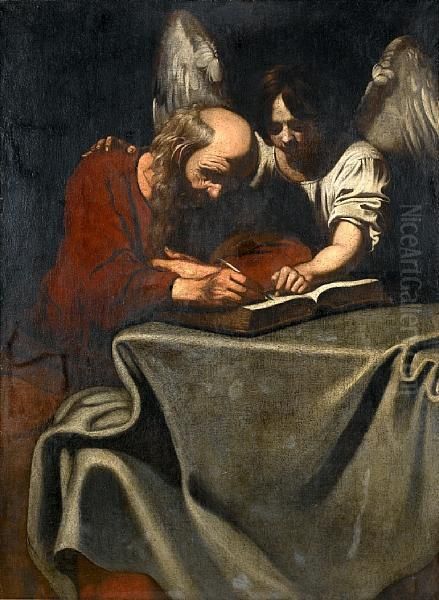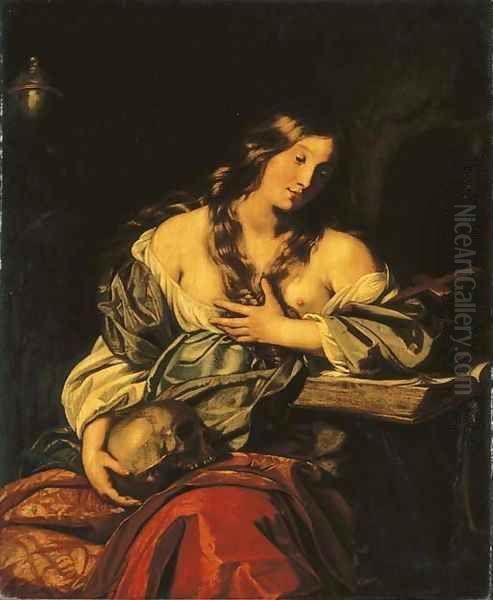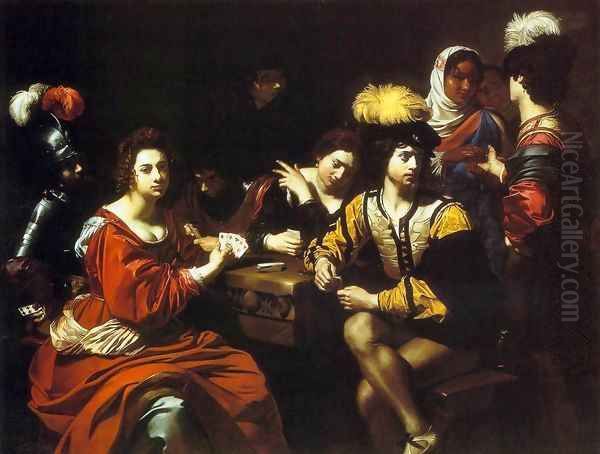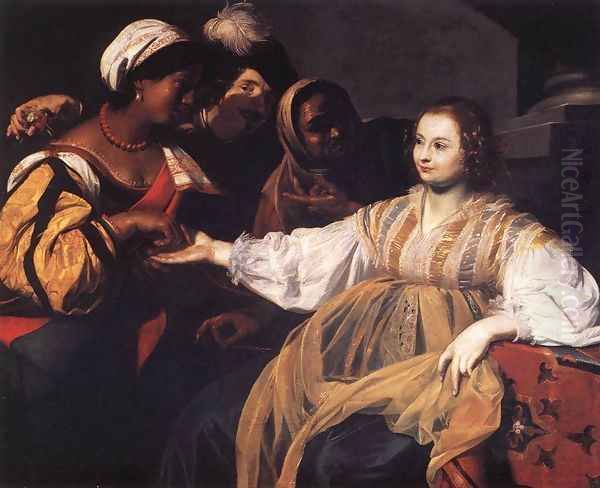Nicolas Régnier, known in Italy as Niccolò Renieri, stands as a fascinating figure in the landscape of 17th-century European art. A painter of Flemish origin, his career traversed the vibrant artistic centers of Antwerp, Rome, and Venice, each leaving an indelible mark on his evolving style. Born in Maubeuge in the County of Hainaut (then part of the Spanish Netherlands, now in France) around 1591, and passing away in Venice in 1667, Régnier's life and work exemplify the rich cross-cultural exchanges that characterized the Baroque era. He skillfully navigated the dominant artistic currents of his time, from the dramatic realism of Caravaggism to the opulent colorism of the Venetian school, forging a unique artistic identity that also encompassed roles as a discerning art dealer and collector.
Early Life and Flemish Foundations
Nicolas Régnier's artistic journey began in Maubeuge, a town situated in a French-speaking region of Flanders. His birth year is generally accepted as 1591, though some earlier sources might offer slight variations, the consensus firmly places his birth in the early 1590s. The artistic environment of Flanders at this time was dynamic, with Antwerp serving as a major hub. It was to Antwerp that Régnier went for his formative training, entering the studio of Abraham Janssens.
Janssens (c. 1575–1632) was a significant figure in Flemish painting, a contemporary of Peter Paul Rubens, and one of the earliest artists in the Southern Netherlands to adopt and adapt the revolutionary style of Michelangelo Merisi da Caravaggio. Janssens himself had likely spent time in Rome, absorbing the Italian master's dramatic use of chiaroscuro (strong contrasts between light and dark), his naturalistic depiction of figures, and his preference for depicting saints and biblical figures with a sense of immediacy and human emotion. Régnier's apprenticeship under Janssens, therefore, provided him with a solid grounding in Flemish painting techniques while simultaneously exposing him to the burgeoning influence of Caravaggism, an influence that would profoundly shape his early career. This initial training instilled in him a Northern European meticulousness and a penchant for detailed rendering that would remain a subtle undercurrent even as his style evolved.
The Roman Sojourn: Immersion in Caravaggism

Around 1615, like many ambitious Northern European artists of his generation, Nicolas Régnier made the pilgrimage to Rome. The Eternal City was then the undisputed center of the art world, a melting pot of influences and a place where an artist could make a reputation. For a painter already primed by Janssens in the Caravaggesque manner, Rome offered the opportunity to experience this style at its source and to engage with its leading practitioners.
Régnier is documented in Rome from roughly 1615 to 1625. During this decade, he became deeply involved with the circle of artists known as the Caravaggisti – followers of Caravaggio who adopted and disseminated his stylistic innovations. Among these, Bartolomeo Manfredi (c. 1582–1622) was particularly influential. Manfredi was renowned for popularizing what became known as the "Manfrediana Methodus," which involved depicting genre scenes – card players, fortune tellers, musicians, soldiers – with Caravaggesque lighting and realism, often featuring half-length figures in close-up compositions. Régnier's association with Manfredi was crucial, and his works from this period clearly reflect this connection. He produced numerous paintings of religious and genre subjects that employed the characteristic tenebrism, dramatic lighting, and earthy realism favored by the Caravaggisti.
During his Roman years, Régnier also associated with other prominent artists. He was part of the vibrant community of Northern artists in Rome, which included figures like the Dutch painters Dirck van Baburen and David de Haen, who were also key exponents of Caravaggism. He formed a lasting friendship with the French painter Simon Vouet (1590–1649), another significant figure in Roman Caravaggism who would later become a leading painter in France. Their shared artistic inclinations and experiences in Rome likely fostered a strong bond. The provided information also mentions a collaboration with "Giovanni Battista Caravaggio," described as Caravaggio's nephew. While the precise identity of this "nephew" is not widely established in mainstream Caravaggio scholarship (Caravaggio himself had no known children, and documented artist nephews are scarce), the connection, as stated, points to Régnier's deep immersion within circles directly or indirectly linked to the master's legacy. It's possible this refers to a lesser-known relative or an artist who adopted the name, or perhaps a confusion with another Caravaggesque painter like Giovanni Battista Caracciolo, a leading Neapolitan Caravaggist, though Caracciolo was not Caravaggio's nephew. Regardless, the mention underscores his proximity to the Caravaggesque milieu.

Régnier's talent did not go unnoticed. He gained the patronage of important collectors, most notably Marchese Vincenzo Giustiniani, a prominent banker and one of Caravaggio's most significant patrons. Giustiniani's collection was legendary, featuring works by Caravaggio, the Carracci, and many contemporary artists. Régnier served as a painter for Giustiniani, and his works were included in this prestigious collection. This patronage was a testament to his skill and his successful assimilation of the Caravaggesque style, which was highly fashionable. Works like his Saint Matthew and the Angel exemplify his Roman period, showcasing a mastery of Caravaggesque light and shadow but also, as noted, an infusion of a more "academic" or classicizing form, hinting at an awareness of other artistic trends in Rome, such as the classicism of Annibale Carracci and his followers like Domenichino and Guido Reni.
Stylistic Evolution in Rome
While deeply entrenched in Caravaggism, Régnier's art during his Roman period was not static. The artistic environment of Rome was complex, with Caravaggism coexisting and interacting with a revived classicism stemming from the Bolognese school, championed by artists like Guido Reni, Domenichino, and Francesco Albani. These artists emphasized ideal beauty, balanced compositions, and often a lighter palette compared to the stark drama of the Caravaggisti.
Régnier's work began to show a subtle shift, absorbing some of these classicizing tendencies. His figures, while still possessing a Caravaggesque solidity and presence, sometimes acquired a greater elegance and a smoother finish. The intense, almost harsh, tenebrism of his earlier Roman works started to soften, allowing for more nuanced modeling and a broader range of colors. This evolution suggests an artist responsive to the diverse stimuli of Rome, not content to remain a mere imitator but seeking to synthesize different approaches. His friendship with Simon Vouet, who himself underwent a similar transition from a robust Caravaggism towards a more elegant, classicized Baroque style, might have played a role in this development. The influence of Bolognese classicism, as mentioned in the provided information, is a key aspect of this transition, leading to more complex compositions and a refined use of color even before he left Rome.
The Venetian Period: New Influences and Artistic Maturity
Around 1625-1626, Nicolas Régnier left Rome and moved to Venice, where he would spend the remainder of his long and productive life, dying there in November 1667. The move to Venice marked a significant new phase in his career and artistic development. Venice, with its own rich artistic heritage distinct from Rome's, offered a different set of influences. The Venetian tradition, historically championed by masters like Titian, Veronese, and Tintoretto, placed a strong emphasis on colorito (color and painterly application) and sensuous textures, often contrasting with the Roman and Florentine emphasis on disegno (drawing and design).

In Venice, Régnier quickly established himself as a leading painter. He became an important figure in the local art scene, maintaining connections with Venetian artists and continuing to attract prestigious commissions. His style underwent a further transformation, absorbing the Venetian love for rich colors, opulent fabrics, and a more luminous, atmospheric light. While the lessons of Caravaggism were never entirely abandoned – a certain dramatic flair and psychological intensity often remained – his palette brightened considerably, and his compositions became more elegant and sophisticated, sometimes displaying a refined sensuality.
He associated with other foreign artists active in Venice, such as the German painter Johann Liss (c. 1597–c. 1631), whose vibrant color and dynamic brushwork were influential in Venetian painting of the period. The provided information notes that Liss influenced Régnier's depiction of flesh tones, which likely became warmer and more lifelike under this influence. Régnier's ability to adapt and integrate new influences while retaining his own artistic personality was a hallmark of his career.
Régnier as Art Dealer and Collector
Beyond his prolific output as a painter, Nicolas Régnier carved out a successful career as an art dealer and collector in Venice. This was not uncommon for artists at the time, but Régnier seems to have been particularly astute in this domain. His expertise, honed through years of practice and a discerning eye, allowed him to trade in artworks, including paintings by earlier masters and contemporaries. He was also known for his ability to identify forgeries, a valuable skill in the active Venetian art market.
His activities as a dealer and collector undoubtedly contributed to his considerable wealth. More importantly, they kept him in constant contact with a wide range of artworks, further broadening his artistic knowledge and potentially influencing his own painting. His collection was said to be extensive, and at his death, he left behind a significant artistic and material legacy. This dual role as creator and connoisseur enriched his understanding of art and solidified his position within the Venetian art world. His four daughters, Lucrezia, Clorinda, Angelica, and Anna, were also painters, suggesting a family deeply immersed in the arts. Clorinda, in particular, gained some recognition.
Artistic Style and Thematic Concerns

Nicolas Régnier's artistic style is best characterized by its synthesis of diverse influences. His Flemish origins provided a foundation of meticulousness. His Roman period imbued his work with the dramatic intensity and naturalism of Caravaggism, evident in his strong chiaroscuro, his depiction of figures with a tangible sense of volume, and his ability to convey powerful emotions. His subsequent exposure to Bolognese classicism introduced a greater elegance, refinement, and compositional balance. Finally, his long Venetian period infused his art with a richer palette, more sensuous textures, and a luminous atmosphere.
His mature style, therefore, often presents a sophisticated blend: the dramatic lighting of Caravaggio might be softened, the figures rendered with a Northern precision yet imbued with Italianate grace, and the whole composition bathed in a warm, Venetian light. He excelled in depicting luxurious fabrics, gleaming armor, and expressive faces.
Régnier's thematic range was broad. He painted numerous religious scenes, often choosing moments of high drama or intense devotion, such as The Penitent Magdalene or Saint Sebastian Tended by Saint Irene. Mythological subjects, popular in the Baroque era, also featured prominently in his oeuvre, allowing for depictions of the nude and explorations of classical narratives. He was a skilled portraitist, capturing the likenesses of his sitters with acuity and often a touch of aristocratic elegance. Genre scenes, particularly from his earlier Caravaggesque phase, depicted musicians, card players, and fortune tellers, following the tradition of Manfredi. His later works sometimes leaned towards allegorical and historical subjects, executed with a refined and often decorative sensibility.
Representative Works and Their Distribution
Several key works illustrate Nicolas Régnier's artistic journey and stylistic characteristics.
The Penitent Magdalene: This subject was popular during the Counter-Reformation, and Régnier painted it multiple times. These depictions typically showcase his skill in rendering emotion and sensuous textures, often combining Caravaggesque drama with a later elegance. One version mentioned as being on the auction market highlights the continued appreciation for his work.
L'Annonciation (The Annunciation): A religious theme central to Christian art, Régnier's interpretation, preserved in the Church of Saint Teresa (presumably in Venice or a related collection), would likely demonstrate his mature style, blending narrative clarity with painterly richness.
Saint Matthew and the Angel: A product of his Roman period, this work (versions exist, e.g., in the Ringling Museum, Sarasota) shows his engagement with Caravaggesque models but, as noted, with a more academic or classicizing formal structure.
David and Goliath: This dramatic biblical scene, with a version in the Museum der bildenden Künste in Leipzig, allowed Régnier to explore dynamic composition and intense emotion, characteristic of the Caravaggesque approach to narrative.
Young Woman at Her Toilette (Vanitas): Housed in the Musée des Beaux-Arts de Lyon, this painting is a fine example of a theme that combines portraiture, genre, and allegory. Such scenes often carried moralizing undertones about the transience of beauty and worldly pleasures, a common Baroque motif. Régnier's treatment would likely emphasize rich fabrics and a reflective mood.
Self-Portrait as a Bravo (Galleria degli Uffizi, Florence - though sometimes debated): If authentic, this work would show his engagement with a specific Caravaggesque character type, the swaggering bravo or soldier.
Cardsharps and Fortune Teller (Museum of Fine Arts, Budapest): This work is a classic example of the "Manfrediana Methodus," showcasing Régnier's early mastery of Caravaggesque genre scenes.
His paintings are now found in numerous prestigious museums and private collections across the world, including the Louvre in Paris, the Hermitage Museum in Saint Petersburg, the Kunsthistorisches Museum in Vienna, the National Gallery in London, and various galleries in Italy, France, Germany, and the United States. The dispersal of his works attests to his contemporary success and enduring appeal. Some of his works, particularly from his early period, have in the past been misattributed to Caravaggio himself or other prominent Caravaggisti, a testament to his skill in emulating and mastering that style.
Anecdotes and Personal Life
Despite his significant artistic output and his active role in the art market, details about Nicolas Régnier's personal life remain relatively scarce, which is not unusual for artists of this period unless they were subjects of extensive contemporary biographies like those by Karel van Mander (though too early for Régnier) or Joachim von Sandrart (who does mention him). The provided information notes his personal life was "relatively low-key." He married Cecilia Bezzi in 1626, shortly after his arrival in Venice. As mentioned, they had four daughters who also became painters: Angelica, Anna, Clorinda, and Lucrezia. Lucrezia married the painter Daniel van den Dyck, while Clorinda married the prominent Venetian painter Pietro della Vecchia, further integrating Régnier's family into the Venetian artistic fabric.
One interesting aspect of his later career in Venice was his involvement in authenticating artworks and, as mentioned, identifying fakes. This suggests a respected connoisseurship. His accumulation of wealth through painting and art dealing allowed him to live comfortably and to build his own significant art collection, which reportedly included works by masters such as Titian, Tintoretto, and Rubens, alongside many of his own paintings.
Legacy and Historical Significance
Nicolas Régnier's legacy is that of a highly skilled and adaptable painter who successfully navigated the major artistic currents of the 17th century. He was a key figure among the "International Caravaggisti," those artists from various parts of Europe who flocked to Rome and helped to disseminate Caravaggio's revolutionary style. His ability to absorb the essence of Caravaggism – its dramatic naturalism and psychological insight – without becoming a slavish copyist, set him apart.
His subsequent move to Venice and his embrace of Venetian colorism and elegance demonstrate his artistic intelligence and versatility. He became one of the leading painters in Venice during a period when the city was still a vibrant artistic center, though perhaps past its High Renaissance peak. His work represents a fascinating fusion of Northern European precision, Roman Caravaggesque drama, Bolognese classicism, and Venetian painterly richness.
While perhaps not as revolutionary as Caravaggio or as overwhelmingly dominant as Rubens or Bernini, Régnier played an important role as a transmitter and synthesizer of styles. His paintings were sought after by discerning collectors in his lifetime, and his influence can be seen in the work of some of his Venetian contemporaries and followers. His career underscores the cosmopolitan nature of Baroque art and the fruitful interactions between artists of different nationalities and training. He remains an important figure for understanding the complexities of 17th-century painting, particularly the diffusion and transformation of Caravaggism outside of Rome and its eventual mellowing into a more broadly elegant Baroque manner. His life, spanning from the Spanish Netherlands to the heart of Italian art, truly reflects the interconnectedness of European culture in his era. His death in Venice in 1667 marked the end of a long and distinguished career that left a rich body of work for future generations to appreciate.